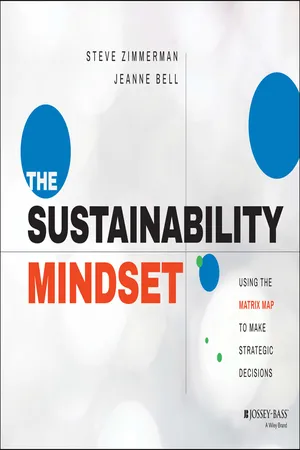
The Sustainability Mindset
Using the Matrix Map to Make Strategic Decisions
- English
- ePUB (mobile friendly)
- Available on iOS & Android
The Sustainability Mindset
Using the Matrix Map to Make Strategic Decisions
About this book
The Matrix Map—a powerful tool for nonprofit strategic decision-making
Nonprofit sustainability lies at the intersection of exceptional impact and financial viability. The Sustainability Mindset offers nonprofit professionals and board members a step-by-step guide to move your organization towards this intersection. As outlined in the bestselling book Nonprofit Sustainability, " The Matrix Map" is an accessible framework that combines financial and programmatic goals into an integrated strategy. In this next-step resource, the authors detail a rigorous process to develop a meaningful Matrix Map and engage leadership in setting an organization's strategy.
Nonprofits that thrive in today's environment are adaptable with a clear understanding of their impact and business model. This book offers nonprofit boards and staff a framework to do so. Drawing on their in-depth experience, the authors provide an easy-to-follow process complete with tools and templates to help organizations visualize their business model and engage in strategic inquiry. The book provides a variety of illustrative examples to show how the Matrix Map works for all types of organizations. Nonprofit executives and board member are sure to benefit from The Matrix Map analysis.
- Offers step-by-step guidance for creating a Matrix-Map, a visual representation of an organization's business model
- Helps organizations assess how each of their programs contributes toward their desired impact and their financial bottom-line.
- Filled with compelling examples of how The Matrix Map helps nonprofits with strategic decision-making
- Written by the coauthors of the groundbreaking book Nonprofit Sustainability
This comprehensive resource will give any nonprofit the framework they need to make decisions for sustainability and the templates and tools to implement it and help leaders address the challenges inherent in balancing mission impact with financial viability.
Frequently asked questions
- Essential is ideal for learners and professionals who enjoy exploring a wide range of subjects. Access the Essential Library with 800,000+ trusted titles and best-sellers across business, personal growth, and the humanities. Includes unlimited reading time and Standard Read Aloud voice.
- Complete: Perfect for advanced learners and researchers needing full, unrestricted access. Unlock 1.4M+ books across hundreds of subjects, including academic and specialized titles. The Complete Plan also includes advanced features like Premium Read Aloud and Research Assistant.
Please note we cannot support devices running on iOS 13 and Android 7 or earlier. Learn more about using the app.
Information
Chapter 1
Introduction
Defining Nonprofit Sustainability
Definition
The Context Today
On Strategy

Table of contents
- Cover
- Contents
- Title
- Copyright
- Acknowledgments
- Chapter 1: Introduction
- Chapter 2: The Matrix Map
- Chapter 3: Getting Started
- Chapter 4: Articulating Impact
- Chapter 5: Assessing Mission Impact
- Chapter 6: Determining Profitability
- Chapter 7: Creating Your Map
- Chapter 8: Reading the Matrix Map: Developing the Key Messages
- Chapter 9: Program-Level Strategic Inquiry
- Chapter 10: Case Studies
- Chapter 11: Bringing it All Together: The Tools and Processes of the Sustainability Mindset
- The Authors
- Advertisement
- Index
- End User License Agreement